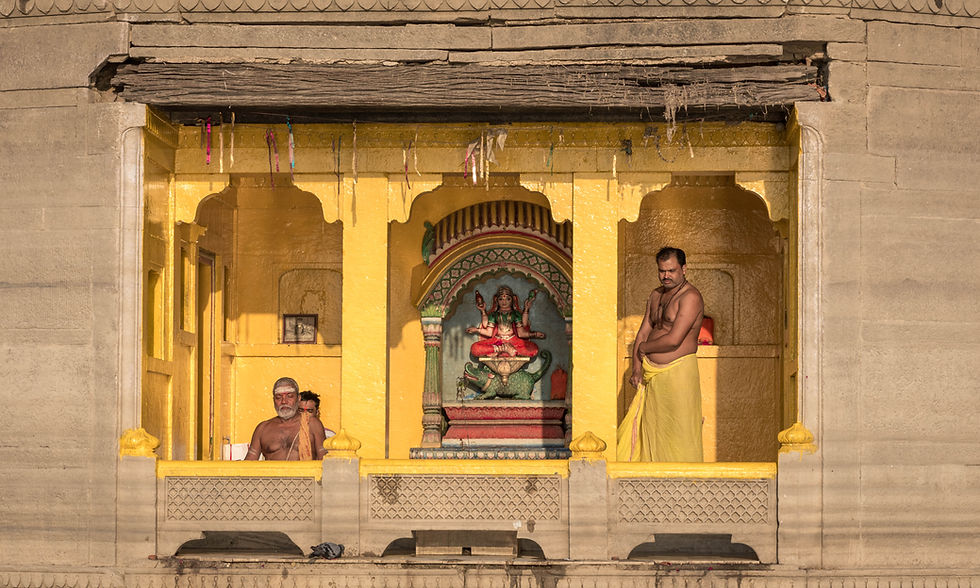Varanasi – the coming together of chaos and calm
- Anirudh Makker
- Aug 13, 2020
- 4 min read
Updated: Jun 21

Varanasi, also known as Benares, is among the world's oldest inhabited cities. In India, it is revered as a sacred place for Hindus. Nupur and I had been intending to visit for quite some time, but plans kept getting postponed for various reasons. Fortunately, this year was different. Earlier in the year, we were on a trip to Ladakh but were holed up in our hostel for 3 days due to a ferocious storm. During this downtime in our Leh hostel, we made a few friends, including a South American guy who shared his Varanasi experience with us. That was when we decided to commit to visiting Varanasi in November and booked our tickets. Little did we know that our visit would coincide with the festival of Dev Diwali, celebrated on the full moon day in Kartika (Nov-Dec), exactly 15 days after Diwali.
Chaos is the first thing you experience in Varanasi. As we took a cab from the airport to Assi Ghat (Ghat refers to a series of steps leading to a river, typically used for activities like washing, bathing, or religious ceremonies such as prayers or cremations), we experienced the familiar traffic woes of a medium-sized town in India. However, the situation worsens as you approach the old town. This area is in proximity to the ghats and all the roads leading to the old town start getting narrower, the honking louder and the roadside encroachment more intense. What was supposed to be a 30-minute drive to our modest accommodation on the main street near Assi ghat ended up being 120 minutes of mad max fury.
Finally, we arrived! We paused to catch our breath and then began making our way to the Ghat area as evening had already set in and the Dev Diwali celebrations were about to begin. On a typical day, it might have been a leisurely stroll where you could soak in the local vibe, but today was different. Thousands of people were marching in the same direction, leaving little room to walk. Thankfully, we had a local friend who had reserved a small boat for us to enjoy the festivities. His familiarity with the area allowed him to guide us through narrow alleys to the Assi Ghat. Walking through these alleys feels like stepping back in time. The maze of streets is overwhelming, and it's easy to lose your way. The houses are old yet beautiful, and many feature a small shrine outside.
What is the first word that comes to mind when you think of the Ganga River? For many Indians, it might be Sacred, Holy, Reincarnation, or even pollution. But when you are standing in front of it, you can block out the negative emotions and feel its majesty. This river stretches 2600 km, originating in the remote Himalayas and flowing into the vast Bay of Bengal. The river is steeped in tales of history and mystery, all contributing to its grandeur, a feeling magnified when viewed from the magnificent ghats of Varanasi. We jumped into our boat, and for the next 90 minutes, we hopped from one ghat to another. We disembarked and reboarded at several of the ghats (though there are about 90 of them in total), beautifully adorned with thousands of earthen lamps. It was already dark; prayer ceremonies were underway, and locals were setting off firecrackers. This was an elevating experience. The chaos and hustle seemed worthwhile. Later, we attended the evening prayers and called it a day.
The next morning, we dragged ourselves from bed to head back to the riverbank and take another boat ride to experience the sunrise. And it completely blew us away! The sun slowly rose from behind the eastern barren banks and cast a golden hue on the steadily flowing Ganga and eventually the beautiful ghats. The sun rays were magical as if it was calmness washing over us.



We finished our boat ride, had a quick breakfast, and started exploring the alleys which again lead to various ghats. Though we never planned it, but we ended up at Manikarnika Ghat. This ghat has been designated for cremation ceremonies since ancient times. As you may know, Hindus cremate their deceased, and many believe that if the ashes are immersed in the Ganga, the dead are freed from the cycle of rebirth and attain Moksha (the belief that a soul is liberated from being reborn to endure suffering in this world). Because of this belief, many people perform the final rites of the deceased at these ghats. These ceremonies are held in the open, allowing you to witness the funeral pyres at any time of day. This can be an overwhelming experience for anyone. It certainly was for us, as witnessing the inevitable end of human life instills a sense of humility.

In the afternoon, we went to Sarnath, the site where Gautam Buddha delivered his first sermon after attaining enlightenment. We explored the renowned Bodhi tree, the Sarnath Museum, and concluded our visit at the Dhamek Stupa. It was a beautiful evening and hundreds of people were praying facing the beautiful Dhamek Stupa.

I reflected on why so many people name Varanasi as their Indian experience of choice when the country has so much else to offer. Perhaps it's because, despite the chaos it presents, Varanasi ultimately restores a sense of calmness, balance, and humility. It's this state in which a person can reconnect with himself – and isn't that the reason we travel in the first place!

















Comments